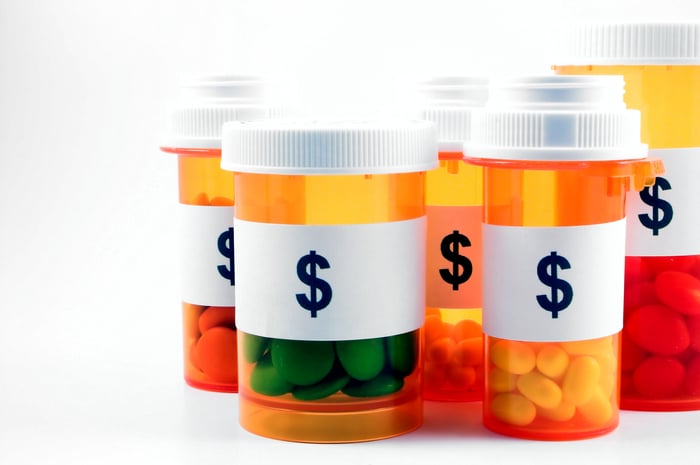
Image source: Getty Images.
Don't look now, but embattled drug company Valeant Pharmaceuticals (BHC 0.70%) has been melting lower once again after experiencing quite the summer rally following its second-quarter report. Despite sticking by its full-year earnings forecast, Valeant shares have lost around a third of their value over the past two months, 78% year-to-date, and more than 91% since its all-time high was hit last summer.
The reason Valeant's stock is struggling so badly is there are more questions than answers at this point.
Will Valeant ever get its pricing power back?
For starters, shareholders are anxious to know when Valeant will get the bulk of its pricing power back. Valeant has been under the increasingly watchful eye of lawmakers since it was disclosed by The Wall Street Journal that Valeant had acquired cardiovascular drugs Nitropress and Isuprel from Marathon Pharmaceuticals in Feb. 2015 and increased their list prices by 525% and 212%, respectively. Were these increases on existing medications not bad enough, no formulation or manufacturing changes were made to either drug. Now-former CEO of Valeant, J. Michael Pearson, testified in front of a Senate committee earlier this year that he and his management team had made "mistakes" in Valeant's pricing strategy, which effectively pointed a bull's-eye on the company's pricing practices moving forward.

Image source: Getty Images.
Of course, Valeant's questionable pricing practices didn't end with this duo of cardiovascular drugs. Just over a week ago, Bloomberg reported that Valeant had cut ties with specialty pharmacy Direct Success, which sold the antidepressant Wellbutrin XL on Valeant's behalf (though Direct Success was only responsible for about 5% of Wellbutrin XL's annual sales). Wellbutrin XL is Valeant's second-best-selling drug; and despite volume for the drug dropping, the 11 price increases Valeant passed along over a two-year period ensured that revenue rose.
It's unclear at this point when Valeant will no longer be under the watchful eye of regulators, or if the company could face fines or sales restrictions based on ongoing legal probes into its business practices.
Can Valeant reduce its debt enough to improve its financial flexibility?
But the more immediate issue for Valeant is whether it can reduce its $30.77 billion in debt to more manageable levels. The company has had to renegotiate with its lenders twice this year, which has resulted in fees and higher interest rates that have choked its ability to make acquisitions, which is troublesome since M&A has been its primary method of growth.
In response to its high debt levels, CEO Joseph Papa has suggested that the company would sell its non-core assets, which amount to about 20% of its annual sales and in the neighborhood of $725 million in annual EBITDA. It was management's opinion that Valeant could net $8 billion in return for the sale of its non-core assets.
This for-sale sign might be sitting on the lawn for a while
One such asset currently on the block is Australia's iNova Pharmaceuticals, which Valeant acquired in 2011 for about $700 million, inclusive of business milestone payments. iNova Pharmaceuticals is best-known for its weight management drug Duromine, as well as over-the-counter cough and cold brands Difflam, Nyal, and Duro-Tuss, Australia's leading cough brand. Valeant is looking to get more than $1 billion for iNova, and it's appointed Goldman Sachs to take the lead on disposition discussions. But that was more than a month ago, and the for sale sign continues to sit in iNova's front yard, much to Valeant's dismay.

Image source: Getty Images.
According to various news sources, iNova generated about $100 million in EBITDA in the most recent fiscal year. If Valeant were to hit its expected 11 times EBITDA figure, it would net roughly $1.1 billion from the sale of iNova. But, the problem is that Valeant is probably in no position to bargain over price on any of its assets. Its lenders have made it crystal clear that the company needs to lower its debt to improve its liquidity and increase its EBITDA-to-interest cost coverage ratio. Valeant's peers are fully aware of this, which means it's not in their best interest to chase any of Valeant's assets valued at a premium.

Image source: Getty Images.
When iNova was acquired, it was deemed to have annual revenue around $200 million. It's impossible to state what those sales are today since Valeant doesn't break them out in its annual reports, but chances are that growth in an OTC medicines market hasn't been in the double-digits since it was acquired in 2011. If I were to venture a guess, iNova probably has annual sales around or under $250 million. This means Valeant is asking for around or above four times annual sales, which is an exceptionally high price considering that most biotech acquisitions over the past two years have been for around three times peak sales of a lead drug -- and lead drugs typically grow at a much faster rate than OTC therapeutics.
My suspicion as to the reason why iNova hasn't been acquired yet has more to do with the price Valeant is asking than the suitors simply not caring for the products iNova offers. If the former is true, Valeant could have a far more difficult time than expected lowering its debt levels and achieving greater financial flexibility.
Looking ahead
The next big test for Valeant is the release of its third-quarter financial results on Election Day, Nov. 8. Hopefully investors will learn a lot more about the success or failure of its asset sales thus far, and they'll get a better bead on what steps management plans to take to turn the company around. For the time being, this Fool would suggest investors keep their distance from Valeant, whose business model is still very much in flux.





